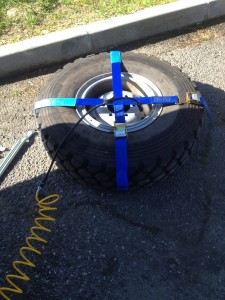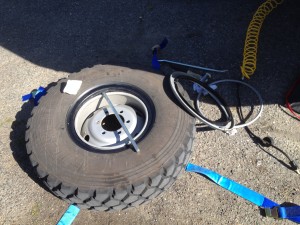Balancing beads in tyres dynamically balance the wheels whilst driving, compensating for any mis-balance due to wear and tear or due to clumps of mud that may have been stuck to the tyre. I had used balancing beads in my Toyota Fortuner in Qatar and been quite impressed with their performance.
Installing the balancing beads with split-rim wheels
To install the balancing beads I needed to open up the wheel; they cannot be poured in through the valve. Cuthbert is fitted with military specification split-rim wheels that can be used with or without inner tubes. I am operating without inner tubes as I believe this is the best option (although I am carrying a couple of inner tubes for any ‘emergencies’ that I may encounter in Africa).
Splitting the rim
To ‘open’ the wheel I needed to split the rim. First I deflated the tyre then broke the tyre bead from the wheel, which can sometimes be difficult. I have a set of Australian tyre pliers for this job, but on this occasion I could simply step on the tyre to break the beads.
Once the bead was broken a gentle tap with a rubber mallet freed the wheel’s outer rim; then with the use of a couple of tyre leavers the locking ring could be removed. I then removed the outer rim and the sealing ring below it, from the wheel. The tyre was then free to be lifted off the wheel, which I did just enough to drop in the small bag of balancing beads.

Re-inflating the tyre after installing the balancing beads (the safety strap is a precaution because the wheels have split rims)
Reassembly
I then reassembled the wheel in reverse order (making sure the locking ring was seated correctly) and re-inflated the tyre with a compressor. Split rim wheels have been known to come apart quite violently during re-inflation if the locking ring is not seated correctly. I therefore used as an added safety precaution, a set of safety straps that go around the wheel while it was re-inflated. As is quite common when inflating a tyre that has just been fitted, the tyre beads were not sealing completely; air was escaping and preventing re-inflation. I found that by simply lifting the wheel slightly in the middle, the tyre seated itself nicely and a seal was obtained.
Click here to see more about our Tyres and Wheels and our first Tyre Blow-out!

